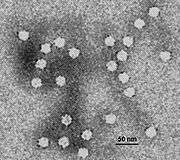Canine minute virus
| Canine minute virus | |
|---|---|
 | |
| EM of canine parvovirus | |
| Virus classification | |
| Group: | Group II (ssDNA) |
| Family: | Parvoviridae |
| Subfamily: | Parvovirinae |
| Genus: | Bocavirus |
| Species: | Carnivore bocaparvovirus 1 |
Canine minute virus (or minute virus of canines; MVC) is a strain of Carnivore bocaparvovirus of the family Parvoviridae that infects dogs. It is similar to bovine parvovirus in its protein structure and DNA.[1] A virus causing respiratory disease in humans has been called human bocavirus due to its similarity to these viruses.[2] Canine minute virus was originally discovered in Germany in 1967 in military dogs,[3] although it was originally thought to not cause disease. Dogs and puppies are infected orally, and the virus is spread transplacentally to the fetuses. Symptoms are seen most commonly between the ages of one to three weeks[3] and include severe diarrhea, difficulty breathing, and anorexia. In severe cases, illness can be fatal.
In experimental infections, the virus is spread transplacentally when the dam is infected between 25 and 30 days of gestation and can result in abortion. When the dam is infected between 30 and 35 days, the puppies were sometimes born with myocarditis and anasarca.[3] Pathological lesions in fetuses in experimental infections were found in the lung and small intestine.[4]
Virology
The genome is 5.4 kilobases in length. The termini are palindromic. There is a single P6 promoter which through the mechanism of alternative splicing and alternative polyadenylation two nonstructural proteins (NS1 and NP1) and two capsid proteins (VP1 and VP2) are transcribed. The NS1 protein is indispensable for genome replication. The NP1 protein, unique to the Bocaparvovirus genus, appears to be critical for optimal viral replication, as the NP1 knockout mutant of MVC suffers from severe impairment of replication.
References
- ↑ Schwartz D, Green B, Carmichael L, Parrish C (2002). "The canine minute virus (minute virus of canines) is a distinct parvovirus that is most similar to bovine parvovirus". Virology. 302 (2): 219–23. PMID 12441065. doi:10.1006/viro.2002.1674.
- ↑ McIntosh K (2006). "Human bocavirus: developing evidence for pathogenicity". J Infect Dis. 194 (9): 1197–9. PMID 17041844. doi:10.1086/508228.
- 1 2 3 Carmichael, L. (2004). "Neonatal Viral Infections of Pups: Canine Herpesvirus and Minute Virus of Canines (Canine Parvovirus-1)". Recent Advances in Canine Infectious Diseases. Archived from the original on 2006-08-18. Retrieved 2006-06-25.
- ↑ Hashimoto A (1999). "Canine parvovirus type-1 (MVC): Pathomorphological studies on the experimentally infected fetus and MVC-infected cultured cells". Canine Infectious Diseases: From Clinics to Molecular Pathogenesis. Retrieved 2007-04-07.